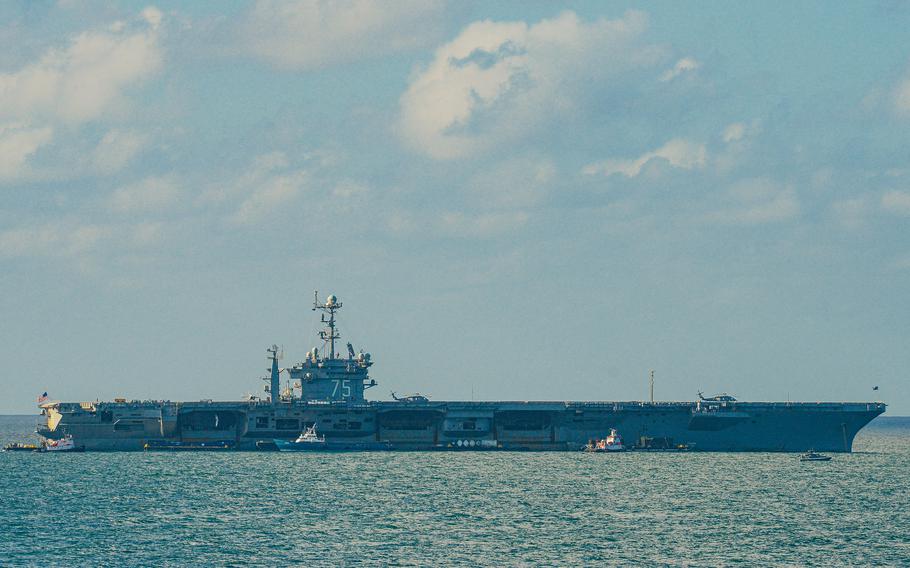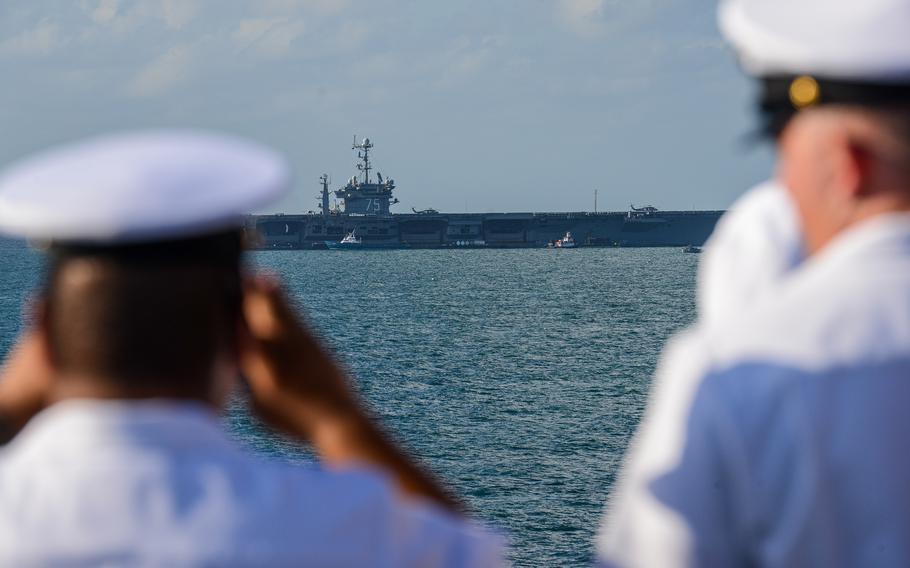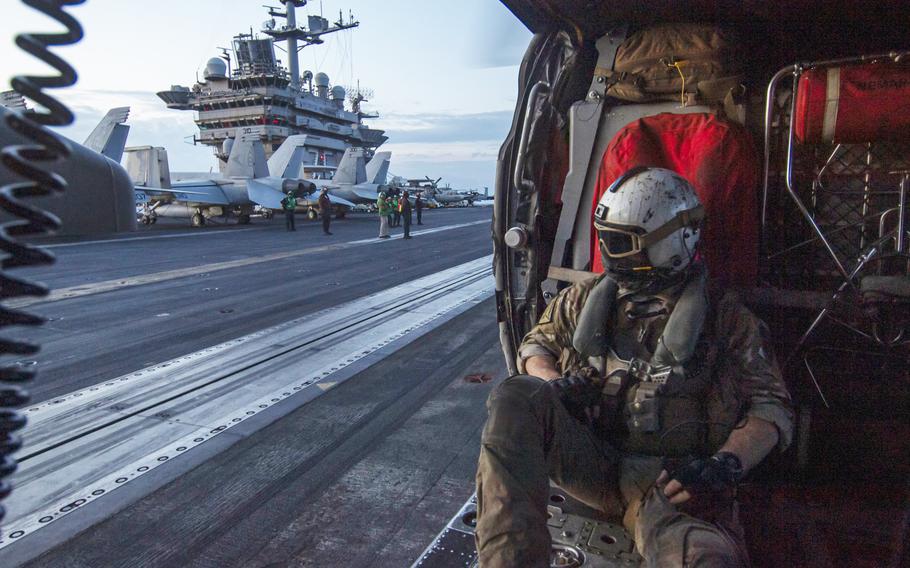
The USS Harry S. Truman, a nuclear-power aircraft carrier, is pictured off the coast of Miami on Sunday, May 5, 2024. The ship was visiting Miami’s Fleet Week during its ongoing train up to prepare it to deploy to the Red Sea later this year. (Corey Dickstein/Stars and Stripes)
MIAMI — The USS Harry S. Truman will soon lead a Navy strike group into the volatile Red Sea, where U.S. sailors have fought almost daily for months to down drones and missiles launched by Houthi rebels from Yemen.
The nuclear-powered aircraft carrier and its 6,000-some sailors have spent recent months training in the western Atlantic Ocean for that mission — a rare, pre-planned deployment expected to take the ship into a hostile environment. In recent weeks, its sailors have been undergoing flight deck testing, its pilots knowing that later this year they will be tasked with shooting down drones and munitions launched by the Iran-backed Houthis.
“They know that they’re most likely going to be entering a weapon engagement zone,” said Adm. Daryl Caudle, the leader of U.S. Navy Fleet Forces Command. “I believe, personally, that puts higher stakes on why what we do [in training] is so important. … For this group, this [deployment] is not with the mindset that they’re just going to go drill holes in the water somewhere — this is, ‘We’re going to be employed for combat.’ ”
But with combat on the minds of the Truman’s sailors and preparations being made to deploy to the hostile waters of the Red Sea, the 1,000-foot-long, 104,000-ton aircraft carrier made a rare appearance in Miami to have the ship’s sailors participate recently in the city’s first Fleet Week.

Sailors aboard the USS Bataan, an amphibious assault ship, look out at the USS Truman aircraft carrier as the Bataan pulls into the port of Miami for Fleet Week on Sunday, May 5, 2024. (Corey Dickstein/Stars and Stripes)
There was some “pushback” from Navy planners, Caudle admitted. An aircraft carrier had never participated in a U.S. Fleet Week anywhere. But when Fleet Week kicked off May 5, the Truman sat stoic, anchored just a few miles off the coast of Miami Beach — its sailors gathered on the flight deck to wave emphatically at their counterparts aboard the USS Bataan, as the amphibious assault ship entered Miami’s port.
“I will admit that bringing a nuclear-powered aircraft carrier to a Fleet Week is unique,” said Caudle, who is charged with providing trained and ready naval forces to combatant commanders around the world. “And of course ... they’re [in the middle of] doing the training … they need to do to ensure that they’re certified and qualified and proficient and ready to go fight. Fleet Week is not built into that.”
The crew used the voyage from its home base in Norfolk, Va., to Miami and back — the Truman returned Friday to Norfolk — to conduct extra tactical training at sea, Caudle said. The carrier’s time in Miami was largely meant to give sailors a fun port call and to interact with the local community, a sort-of recruiting effort that top Navy officials, including Caudle, said they hoped would spark interest in the sea service among more young Miamians.
The admiral said he hoped the Fleet Week stop, wedged into a critical train-up for what would likely be the most dangerous deployment most of the sailors have ever served, would spark memories of their service and bolster their quality of life in the Navy.
“Once they actually come over to the city, and immerse themselves into this incredible town, and get to experience the food, and the people, and the nightlife and all that, that is what builds the memories, and [that is] why people stay in the Navy,” Caudle said. “I’m going to be honest; this is what I remember from my almost 40-year career are the places I’ve pulled into. The operations tend to be a bit of a blur, but you really remember the port calls.”
With Fleet Week over, the bulk of the Truman’s preparations begin.
Navy officials declined to say precisely when the Truman will embark on its cross-Atlantic voyage toward the Red Sea to replace the USS Dwight D. Eisenhower, which deployed from Norfolk in October. Caudle said the deployment was still “several months out.” The Eisenhower briefly left the Red Sea last month for the Mediterranean Sea, but it has recently returned to the Red Sea, according to the Navy.

Naval Air Crewman 2nd Class Matthew Watkins, a native of Anthem, Ariz., attached to the “Dragonslayers” of Helicopter Sea Combat Squadron 11, sits in an MH-60S Sea Hawk helicopter as it prepares to launch from the flight deck of the Nimitz-class aircraft carrier USS Harry S. Truman on April 25, 2024, in the Atlantic Ocean. (Michael Shen/U.S. Navy)
The Navy canceled a planned visit to the Truman for news reporters during the Miami Fleet Week, and the ship’s top leaders were not made available for interviews.
Caudle said he was confident in the ship’s ongoing preparations. The Navy was already incorporating “lessons learned” in the Truman crew’s training from the Eisenhower strike group’s fighting with the Houthis.
While the admiral declined to provide specifics about most of those new lessons, he said they are informing the scenarios that the Truman has faced in its training. Ultimately, as the carrier completes its pre-deployment training, the ship will deal with similar issues that the Eisenhower and its escort ships have faced in the Red Sea, Caudle said. Those include lessons on some strategies such as where a strike group’s ships should be in relation to one another, how its radar systems should be tuned and the decision-making processes on which weapon should be employed against which incoming munition and when, he said.
“We’re taking all these lessons from [the Eisenhower] strike group in real time … and bringing all those lessons we’ve learned to bear in the scenarios that we use against Truman to make sure that is the most relevant set that we can build for them,” Caudle said.
The Eisenhower and her strike group have faced nearly six months of fighting in the Red Sea. While the group’s destroyers have been credited with taking down many of the drones and missiles fired by Houthi rebels into crowded shipping lanes, the Eisenhower’s aircraft have flown near constant missions in the area, Navy officials have said. The carrier’s fighter planes have shot down drones and missiles and launched so-called “dynamic strikes,” often to take out ballistic missiles that appear ready for launch, Pentagon officials have said in recent months.
Truman will bring some 90 aircraft, including F/A-18 Super Hornet fighter jets, E-2D Hawkeye command and control aircraft, E/A18 Growler electronic warfare jets, and MH-60 Seahawk helicopters.
It will likely enter conditions that another top admiral described this week as the most volatile that Navy sailors on deployed ships have faced since World War II.
“They have to be prepared on a moment’s notice to conduct engagements,” Rear Adm. Fred Pyle, the service’s surface warfare director, said Tuesday at the Center for Strategic and International Studies think tank in Washington. “And they have to get it right every single time.”
.jpg/alternates/LANDSCAPE_910/8365568%201.jpg)
Sailors conduct flight operations on the flight deck of the Nimitz-class aircraft carrier USS Harry S. Truman on April 24, 2024, in the Atlantic Ocean. (Matthew Nass/U.S. Navy)
Pyle and Caudle said they have been impressed with the Eisenhower strike group’s successes in the Red Sea, where the ships are leading a coalition of some 24 nations supporting Operation Prosperity Guardian, the international mission to thwart the Houthi attacks. The rebel group, which receives its arms and other support from Iran, has claimed the attacks are in response to Israel’s ongoing war against Hamas in Gaza, which was launched after the surprise attack by Hamas militants on Israeli civilians in October.
U.S. Central Command, which oversees American military operations in the Middle East including the Red Sea, has sent out near daily readouts of engagements between coalition Navy personnel and the Houthis. Pyle said the operations successes have bolstered confidence in the systems that the service has invested in to protect sailors aboard its ships.
“The threats they’re engaging [in the Red Sea] are unmanned, they’re anti-ship cruise missiles, they’re anti-ship ballistic missiles, and in each one of those threat groups we’re performing well,” Pyle said. “And the systems and the sailors are performing as designed and great.”
Caudle said he expected the Truman strike group would seamlessly pick up the mission and perform just as well as the Eisenhower group has to date. Talking to the ship’s sailors, the admiral said, he can sense they are ready to get in the fight.
“I think people join a combat service, you know, to be part of a combat team,” Caudle said. “They want to go and actually exercise that and do what they do for a living and … be stressed to the ultimate limit out there.
“In the Red Sea right now, we’re bringing the full complement of naval combat power to bear. ... But we want to deter conflict. That is the main effort. There is nothing that does that more than 100,000 tons of diplomacy in an aircraft carrier.”